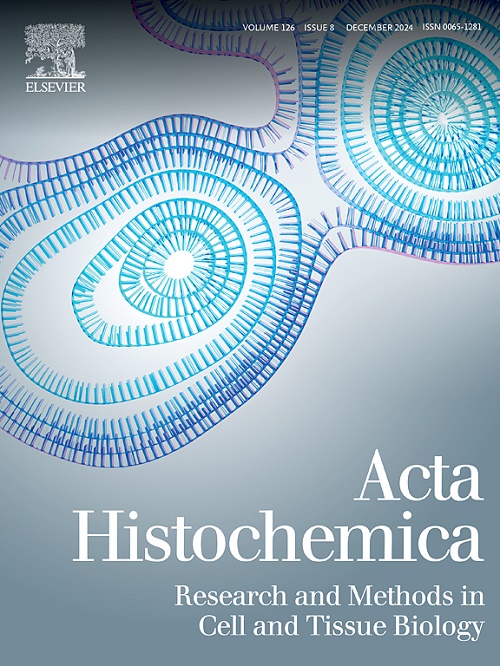Advancing triple-negative breast cancer therapy: 3D in vitro models to unravel drug resistance mechanisms and tumor microenvironment interactions
IF 2.4
4区 生物学
Q4 CELL BIOLOGY
引用次数: 0
Abstract
Triple-negative breast cancer (TNBC) poses considerable clinical challenges due to its aggressive nature, early metastasis, and limited treatment options. The simplified 2D models and the physiological differences in animal models often result in inconsistent responses to anticancer drugs. To tackle these challenges, three-dimensional (3D) in vitro bioengineered models that accurately replicate the in vivo tumor microenvironment (TME) have been developed, offering a more reliable platform for preclinical drug testing. Recent advancements in cell culture techniques have facilitated the creation of 3D models derived from patient tissues and tumors, which effectively mimic the native tissue environment and exhibit drug sensitivity and cytotoxicity behaviors similar to those observed in vivo. It is increasingly acknowledged that the extracellular matrix and cellular diversity within the TME significantly influence the fate of cancer cells. Consequently, strategies to explore drug resistance mechanisms must account for both microenvironmental factors and genetic mutations. This review examines 3D in vitro model systems that integrate microenvironmental influences to investigate drug resistance mechanisms in breast cancer. We discussed various bioengineered models, including spheroid-based, biomaterial-based (such as polymeric scaffolds and hydrogels), patient-derived xenograft (PDX), 3D bioprinting, and microfluidic chip-based models. Additionally, we discuss the relevance of these 3D models in understanding the effects of TME signals on drug response and resistance, as well as their potential for developing strategies to overcome drug resistance and optimize treatment regimens.
推进三阴性乳腺癌治疗:3D体外模型揭示耐药机制和肿瘤微环境相互作用
三阴性乳腺癌(TNBC)由于其侵袭性、早期转移和有限的治疗选择,给临床带来了相当大的挑战。二维模型的简化和动物模型的生理差异往往导致对抗癌药物的反应不一致。为了应对这些挑战,三维(3D)体外生物工程模型已经被开发出来,可以准确地复制体内肿瘤微环境(TME),为临床前药物测试提供更可靠的平台。细胞培养技术的最新进展促进了来自患者组织和肿瘤的3D模型的创建,这些模型有效地模拟了天然组织环境,并表现出与体内观察到的相似的药物敏感性和细胞毒性行为。越来越多的人认识到,TME内的细胞外基质和细胞多样性显著影响癌细胞的命运。因此,探索耐药机制的策略必须同时考虑微环境因素和基因突变。本文综述了整合微环境影响的3D体外模型系统,以研究乳腺癌的耐药机制。我们讨论了各种生物工程模型,包括基于球体的、基于生物材料的(如聚合物支架和水凝胶)、患者来源的异种移植物(PDX)、3D生物打印和基于微流控芯片的模型。此外,我们讨论了这些3D模型在理解TME信号对药物反应和耐药性的影响方面的相关性,以及它们在制定克服耐药性和优化治疗方案的策略方面的潜力。
本文章由计算机程序翻译,如有差异,请以英文原文为准。
求助全文
约1分钟内获得全文
求助全文
来源期刊

Acta histochemica
生物-细胞生物学
CiteScore
4.60
自引率
4.00%
发文量
107
审稿时长
23 days
期刊介绍:
Acta histochemica, a journal of structural biochemistry of cells and tissues, publishes original research articles, short communications, reviews, letters to the editor, meeting reports and abstracts of meetings. The aim of the journal is to provide a forum for the cytochemical and histochemical research community in the life sciences, including cell biology, biotechnology, neurobiology, immunobiology, pathology, pharmacology, botany, zoology and environmental and toxicological research. The journal focuses on new developments in cytochemistry and histochemistry and their applications. Manuscripts reporting on studies of living cells and tissues are particularly welcome. Understanding the complexity of cells and tissues, i.e. their biocomplexity and biodiversity, is a major goal of the journal and reports on this topic are especially encouraged. Original research articles, short communications and reviews that report on new developments in cytochemistry and histochemistry are welcomed, especially when molecular biology is combined with the use of advanced microscopical techniques including image analysis and cytometry. Letters to the editor should comment or interpret previously published articles in the journal to trigger scientific discussions. Meeting reports are considered to be very important publications in the journal because they are excellent opportunities to present state-of-the-art overviews of fields in research where the developments are fast and hard to follow. Authors of meeting reports should consult the editors before writing a report. The editorial policy of the editors and the editorial board is rapid publication. Once a manuscript is received by one of the editors, an editorial decision about acceptance, revision or rejection will be taken within a month. It is the aim of the publishers to have a manuscript published within three months after the manuscript has been accepted
 求助内容:
求助内容: 应助结果提醒方式:
应助结果提醒方式:


